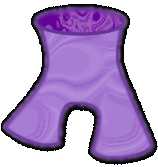One of the major problems with the standard model is resolved by the transition
to string theory. As previously stated, equations cannot be renormalized because
the math will not function correctly at zero distance. With string theory,
however, interactions do not occur at zero distance but rather at the Planck
length ![]() 1.
1.
 |
 |
Another major flaw of the standard model is that it describes the interactions
of elementary particles but not where they come from. This knowledge is known
through experimental data only. String theory should explain where the four
forces come from, why the particles that we see exist, why these particles
have the
masses and charges that they do, why there are four spacetime dimensions that
we live in, and the nature of spacetime and gravity 3.
As strings move through time, they trace out a worldsheet similar to the worldlines
of point
theory. They vibrate, and these different vibrational modes give rise to the
various particles that we can "see". The different modes are seen
as the different masses and spins. String theory possesses the necessary degrees
of freedom to describe all known interactions--something that cannot be said
about the standard model. These degrees of freedom arise from the spacetime
dimensions
that strings live in. Whereas we can only see four spacetime dimensions, string
theory has ten or eleven. Six or seven of these dimensions are curled and thus
effectively invisible; the idea is that motion in these compacted dimensions
gives rise to the properties of the particles 2. Kaluza-Klein
showed that if a fifth dimension were compacted and added to our spacetime,
it would
allow
a four dimensional theory of general relativity plus electromagnetism. If the
electron is allowed this extra degree of freedom, then the photon arises and
the electron obey's Maxwell's equations 3. Elimination
of the extra dimensions through Kaluza-Klein compactification or constrainment
of matter
and gravity
into a three-dimensional subspace called the three brane is called braneworld
theories 5. In the case of Kaluza-Klein compactification,
the extra dimensions are wrapped on Calabi-Yau Manifolds and Orbifolds ![]() that
are far too
small to be seen with modern technology 2. The extra
degrees of freedom afforded by string theory explains more than electrons.
They predict the existence
of the graviton, include the same gauge theories as the standard model, and
predict supersymmetry
that
are far too
small to be seen with modern technology 2. The extra
degrees of freedom afforded by string theory explains more than electrons.
They predict the existence
of the graviton, include the same gauge theories as the standard model, and
predict supersymmetry ![]() at
low energies such as the electroweak scale. Current
particle accelerators are only reaching to about 10^(-16)cm, so point-particle
approximations are still successful as approximations. Once accelerators reach
smaller scales, however, supersymmetry may be revealed and point-particle approximations
may prove to be incorrect 4.
at
low energies such as the electroweak scale. Current
particle accelerators are only reaching to about 10^(-16)cm, so point-particle
approximations are still successful as approximations. Once accelerators reach
smaller scales, however, supersymmetry may be revealed and point-particle approximations
may prove to be incorrect 4.